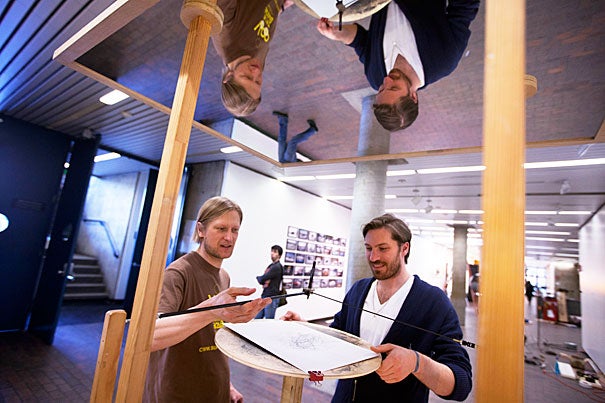
Installation assistants Jesper Dyrehauge (left) and Casper Teichgraber install artwork by Olafur Eliasson in Gund Hall as part of “The Divine Comedy,” a three-part exhibit at Harvard through May 17. The other artists, Ai Weiwei and Tomas Saraceno, have work at the Northwest Science Building and Sert Gallery, respectively.
Kris Snibbe/Harvard Staff Photographer
Art of the ‘Divine’
Exhibit highlights modern echoes of Dante’s medieval realms
When Dante Alighieri wrote his epic poem the “Divine Comedy” early in the 14th century, most Europeans believed in the literal truth of his three realms of the dead: hell, purgatory, and heaven.
Those three still play a metaphorical role and often accurately describe modern reality, from the hellish to the heavenly.
Recently, Dante’s realms found one new life in “The Divine Comedy,” a three-part exhibit at Harvard through May 17, a joint project by the Harvard Graduate School of Design (GSD) and the Harvard Art Museums. The exhibit plays with the notion that the three have parallels in the present-day concepts of history, mind, and cosmos.
History: Outside the Northwest Science Building on Oxford Street is a dramatic reminder that this field is sometimes hell. “Untitled” is a warren of nine towering cubes hung with 5,335 identical backpacks. Each one, with its muted checkerboard of greens and grays, represents a schoolchild killed during the 2008 earthquake in Sichuan, China. The backpacks are lined up like tombstones, and give off a smell of wet cloth. The artist, Ai Weiwei, organized the investigation that found the names of victims in 150 schools in 74 towns.
Mind: At Gund Hall, “Three to Now” by Danish artist Olafur Eliasson displays 54 “experiment-machines” that challenge viewers to investigate the science of seeing — how the mind perceives the real world, and sometimes interprets it as art. Viewers peer into mirrors, globes, peepholes, and even a mesmerizing swirl of dark liquid. The Gund Hall exhibit could be an homage to Dante. His poetic purgatory, a realm where crimes of the mind are punished, explored the science of his time, including the movement of the sun, a spherical Earth, and time zones.
Cosmos: Down the street, on a third-floor terrace of the Sert Gallery in the Carpenter Center for the Visual Arts, Dante’s heaven is on display. “Cloud City,” tethered by 10 guy wires, is a whimsical, 14-sided inflatable device designed by Argentine artist Tomás Saraceno, who is famous for his evocation of habitat platforms that float free and defiant just above the Earth. The buoyancy and silvery look of the Harvard installation recall Dante’s paradise, which the poet conceived as a realm of soul-opening celestial spheres.
“It’s a utopian vision,” said Dan Borelli, sitting near the tethered sphere. “It’s about speculation, uplift, happiness.” He called it a perfect foil to the grim message of Weiwei’s stolid walls of backpacks, with their echo of tragedy.
Borelli is director of exhibits at the GSD, where he is also enrolled as a master’s degree student. He was in charge of the logistics behind the tripartite installation. That included studying average wind speeds on Quincy Street before Saraceno’s air-filled ball could be safely inflated. “Cloud City,” 7 meters across with an outer shell of wind-surfer plastic, weighs only 180 pounds. But its ballast is 10 tons of boxed sand and steel plate.
Inside the sphere, solar panels collect sunlight during the day and power tiny LED lights at night. “They’re like dragonflies in there,” said Borelli. If things work out, “Cloud City” will be launched, tethered, over Cambridge. That would open a conversation about the ownership of “civilian space,” he said, the layer of air between the ground and federal air space.
“The Divine Comedy” has metaphorical impact, but it also represents a new walking tour of Harvard, said Borelli — one that alters, if temporarily, the familiar “psychogeography of the campus,” displacing old sightlines with new.
In the late afternoon of April 8, Borelli walked into Gund Hall, where Eliasson’s array of experiment-machines had attracted a milling crowd for the GSD’s annual open house. The exhibit challenges the idea that the visual can be adequately framed as in a picture, he said. “The world comes in as bits of information. We create the whole in our minds.”
Happily, the crowd had a place to go with questions, — a 5 p.m. artists’ panel discussion in Piper Auditorium, which soon had a standing-room-only crowd. On stage was Eliasson, Saraceno, and exhibition curator Sanford Kwinter, a GSD professor of architectural theory and criticism. Weiwei is under detention in his homeland.
“We have a huge amount to learn from artists,” said GSD Dean Mohsen Mostafavi, introducing the panel. Their brand of social activism, he said, is a constant goad to those who design physical environments.
Both artists trained as architects and accepted the idea that art can inform design — and even science itself, challenging convention in fruitful ways.
Art can help to break the boundaries between disciplines, said Saraceno, which is all the more important in an age when vast, complex problems such as climate change need answers that go beyond technology into the realms of the social and the spiritual. “The work of the artist,” he said, “is to acknowledge the unknown, the ignorance we have.”
Not long ago, “artists were clowns,” said Eliasson. But now they seem to command respect again in serious public discourse, since the complex difficulties of the modern world “call for alternative ways of seeing.”
Are walls of knapsacks, silvery floating orbs, and basins of swirling black water simply physical realities? “The whole idea,” said Eliasson, “is that you are in some sort of emotional contract with the world.”




